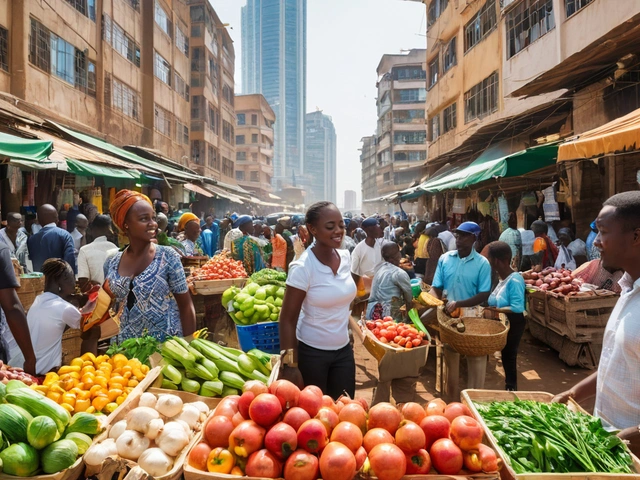As Ethiopia strides forward on its path of economic reform, several sectors emerge as pivotal to its booming business scene. Each sector reveals a unique story of growth, driven by both local innovation and global interactions.
- Agriculture Revolution
- The Rise of Tech Startups
- Tourism and Hospitality Expansion
- Manufacturing and Export Growth
- Energy and Infrastructure
Agriculture Revolution
The transformation in Ethiopia's agricultural sector is not just a tale of increased production; it is a story of profound systemic change that integrates technology and sustainable practices. In the rural landscapes of Ethiopia, where agriculture remains the backbone of the economy, innovative techniques and enhanced crop varieties are setting new benchmarks. Farmers are increasingly adopting practices such as drip irrigation and using improved seed varieties, which has substantially increased the yield per hectare.
Government initiatives have played an instrumental role in this agricultural revolution. By facilitating access to better farming equipment and providing educational programs for farmers, agricultural productivity has seen notable improvement. This not only boosts the domestic supply of food but also strengthens Ethiopia's position in international markets. Export of coffee, one of the country's prime commodities, has seen remarkable growth, contributing significantly to the national economy.
One of the key changes has been the shift towards a more market-oriented approach. Farmers are now more aware of the market demands and are adapting their production accordingly. This economic shift is supported by the infrastructure advancements, like better roads and enhanced logistics, which helps in reducing the post-harvest losses and in getting products to the market fresher and quicker. The result is a more robust and resilient agricultural sector that not only feeds the nation but also creates surplus for export.
Moreover, Ethiopia is harnessing the power of technology to leap forward. The introduction of mobile and cloud technology in rural areas allows farmers to get real-time information on weather and market prices. This integration of technology aids them in making informed decisions that maximize their output while minimizing costs. It's a vivid example of how traditional sectors can transform by embracing modern technology.
The results of these changes are palpable. Not only has there been an increase in agricultural productivity, but there has also been a noticeable improvement in the quality of life for many Ethiopians. The enhanced agricultural practices have led to better food security and have provided more steady income sources for rural families, hence reducing poverty levels considerably. It's a forward-moving segment of the economy that continues to promise growth and opportunities.
The Rise of Tech Startups
The narrative of Ethiopia's tech ecosystem is one of dramatic transformation and compelling growth. In the heart of Addis Ababa and beyond, young entrepreneurs and seasoned innovators alike are harnessing the power of technology to provide solutions to everyday problems, creating a ripple effect across the economy. From mobile apps that simplify banking transactions to agritech platforms that support farmers with real-time data on weather and soil conditions, the scope of these ventures is expansive and varied.
Among these tech startups, names like Gebeya and BlueMoon have gained recognition not only within local borders but also on international stages. These companies illustrate the potential of Ethiopian ingenuity, attracting significant investment from global venture capitalists who are eager to participate in this nasive digital renaissance. Just recently, an Ethiopian fintech startup secured a multi-million dollar investment, signaling strong confidence in the sector's growth trajectory.
The government has played its role by establishing policies that encourage tech innovation and entrepreneurship. Facilitating events and workshops, and providing grants and resources necessary for young startups to thrive. This has created a nurturing environment that allows technology to flourish, turning Ethiopia into a promising hub for tech in Africa. The burgeoning tech scene in Ethiopia is not just growing; it is thriving with an energy that is palpable in the air of startup hubs and innovation labs throughout the city.
What makes Ethiopia particularly enticing for tech startups is not only the availability of a young, tech-savvy population but also the growing infrastructure that supports digital enterprises. For instance, the country is advancing in its digital connectivity, which enables more people to access and leverage the benefits of the internet. Success stories from these tech startups serve as potent testimonials to encourage further innovation. Each successful venture builds confidence among existing and aspiring entrepreneurs, fostering a cycle of inspiration and creation that propels the tech sector forward.
If one were to visit the tech hubs sprawling across Addis Ababa, such as the well-known iceaddis, they would encounter an environment brimming with creative energy and collaborative spirit. Here, young tech enthusiasts gather to brainstorm, develop, and pitch their next big ideas, hoping to become the next big success story. This vibrant scene is supported by an ecosystem of mentors, investors, and fellow entrepreneurs, all connected by a shared vision to drive technological progress. The enthusiasm and commitment seen in these hubs are indicative of the broader momentum gathering across the country's tech landscape.
Tourism and Hospitality Expansion
The allure of Ethiopia's diverse landscapes, from the Simien Mountains to the Danakil Depression, combined with its rich historical tapestry, ranging from ancient rock-hewn churches of Lalibela to the ruins of Aksum, paints a mesmerizing picture for tourists. In recent years, this appeal has been significantly harnessed to grow Ethiopia's tourism and hospitality sector, placing it at the forefront of the country’s economic expansion. Investments have flowed into improving infrastructure, including the enhancement of airports and road networks, making remote areas more accessible and boosting tourist arrivals.
The growth in tourism has spurred developments in the hospitality industry, with an increase in the construction of hotels, resorts, and lodges tailored to cater to international standards. These establishments are not just concentrated in the capital but are sprouting up in regions known for their tourist attractions. By focusing on sustainable and community-based tourism, these businesses aim to preserve the very cultures and environments that attract visitors to Ethiopia.
Government initiatives have also played a crucial role. For instance, the Ethiopian government’s strategic focus on tourism has included easing visa processes and bolstering security, enhancing the overall attractiveness of Ethiopia as a travel destination. International collaborations and marketing campaigns have spread awareness about Ethiopia's unique offerings on the global stage, helping to attract a broader audience.
Economic indicators show promising figures, with the tourism sector contributing a significant chunk to the nation's GDP and employment. Local communities benefit immensely from this growth, seeing substantial improvements in local infrastructure and increases in local employment opportunities in tourism-related enterprises. This holistic development is a stride towards building a sustainable economic model that leverages Ethiopia's cultural and natural heritage.
Manufacturing and Export Growth
Ethiopia's manufacturing sector has witnessed a remarkable transformation in recent years, evolving into a key component of the nation’s economic framework. Spurred by government incentives and an improving regulatory environment, the sector has become particularly attractive to foreign investment. Major manufacturing domains like textiles, leather goods, and agro-processing are not only flourishing but also finding significant markets abroad. This burgeoning sector benefits greatly from Ethiopia's strategic location, providing easy access to both European and Middle Eastern markets.
Among the shining examples of this growth is the textile industry. Renowned for its quality cotton, Ethiopia has attracted major global brands looking to establish production facilities on African soil. Companies are drawn by competitive labor costs and the availability of raw materials. The government's focus on industrial parks has further streamlined operations, making it easier for newcomers to set up and start production with minimal bureaucratic hurdles.
One cannot overlook the impact of the Hawassa Industrial Park, one of the largest eco-industrial parks dedicated to textile and garment production. Launched with the intention to revolutionize the sector, it has markedly increased Ethiopia’s export capabilities. Textile exports have seen a consistent rise, contributing substantially to the national economy. This has been bolstered by a vibrant workforce that is growing in skill and expertise, thanks to extensive training programs funded by both the state and private sectors.
"Ethiopia's strategic implementation of industrial parks is a benchmark in harnessing economic growth through smart infrastructure," an economist remarked, highlighting the pivotal role these complexes play in boosting manufacturing outputs.
The leather industry similarly showcases significant strides, with Ethiopian leather products gaining international acclaim for their quality. Export figures for leather goods have soared, reflecting a refined supply chain and improved production techniques that meet global standards. These successes underline the potential within Ethiopia's borders for transforming traditional sectors into global export leaders.
Furthermore, the development of the manufacturing sector has had a ripple effect on related industries including logistics and technology. Improved roads, better telecommunications, and enhanced logistics services have all played a crucial role in supporting the export-oriented growth strategy. With ongoing improvements in infrastructure, the horizon looks even more promising for Ethiopia’s economic landscape.
Energy and Infrastructure
In the scope of Ethiopia's economic expansion, the sectors of energy and infrastructure stand out as foundational elements driving progress. The government, in partnership with international entities, has embarked on ambitious projects aimed at transforming the nation’s energy access and enhancing infrastructure capabilities. These initiatives are not just about increasing capacity but are also targeted towards sustainable and renewable sources.
One of the flagship projects in this context is the Grand Ethiopian Renaissance Dam (GERD), which upon completion will be the largest hydropower project in Africa. This massive undertaking not only signifies Ethiopia's commitment to renewable energy but is also anticipated to substantially boost the country's power supply, making it a net energy exporter. The ripple effects of such a project are profound, influencing economic activities, from manufacturing to technology.
The drive towards renewable energy is complimented by substantial investments in solar and wind power projects. Ethiopia’s geographical and climatic conditions are favorable for both solar and wind energy production, which the government is eagerly tapping into. These projects not only help in reducing carbon footprints but also play a critical role in rural electrification, thus driving down the historical dependency on biomass.
Infrastructure development is equally vigorous, marked by the construction of new roads, bridges, and railways. These developments are crucial for the internal economic integration, facilitating smoother movement of goods and people across the country. Moreover, Ethiopia's ambition to become a logistics hub for the East African region is heavily reliant on these infrastructural expansions.
Significant to the efficacy of these developments is the involvement of international partners and investors. Financial and technological inputs from global entities catalyze these projects, accelerating progress and enhancing technical capabilities. For instance, the involvement in various infrastructural projects by companies from China and the European Union has introduced new technologies and methodologies in construction and energy production, which significantly bolsters the local skill base.
The comprehensive strategy embraced by Ethiopia in enhancing its energy and infrastructure sectors not only augments its economic stature but also significantly improves the quality of life for its residents. With a sturdy infrastructure network and dependable energy sources, Ethiopia is steadily cruising towards becoming an influential economic figure in Africa.

 Who is the Wealthiest African in 2024?
Who is the Wealthiest African in 2024?
 Bringing Cash into Ethiopia: Limits and Tips for Travelers
Bringing Cash into Ethiopia: Limits and Tips for Travelers
 Understanding Average Income Levels in Ethiopia: Analysis in USD
Understanding Average Income Levels in Ethiopia: Analysis in USD
 Business Sectors Thriving in Africa: Key Opportunities to Explore
Business Sectors Thriving in Africa: Key Opportunities to Explore
 Ethiopian Teacher Salaries: What to Expect in 2024
Ethiopian Teacher Salaries: What to Expect in 2024
love monster
May 2, 2024 AT 22:07Ethiopia's farms are really leveling up fast.
Christian Barthelt
May 3, 2024 AT 00:21While the article mentions drip irrigation, it overlooks that many smallholders still rely on flood irrigation due to cost constraints.
Ify Okocha
May 3, 2024 AT 02:34The piece sugar‑coats the reality that most Ethiopian farmers still struggle with erratic rains, and the supposed tech miracles are barely scratching the surface.
William Anderson
May 3, 2024 AT 04:47Tech hype aside, Ethiopia's startup ecosystem is still tethered to unreliable internet, making any grand vision sound like a fragile house of cards.
Sherri Gassaway
May 3, 2024 AT 07:01One could argue that the true engine of growth lies not in sectors but in the collective will of a nation to redefine its destiny.
Milo Cado
May 3, 2024 AT 09:14The recent surge across Ethiopia’s key industries is a testament to the power of coordinated policy and grassroots innovation. In agriculture, the adoption of drip irrigation, improved seed varieties, and mobile market data has begun to close the productivity gap that has plagued the sector for decades. Farmers who once battled post‑harvest losses now report higher yields and more stable incomes, which in turn fuels local consumption and reduces poverty. The government’s role in subsidizing equipment and building rural roads cannot be understated, as better logistics directly translate into fresher produce reaching markets faster. Meanwhile, the tech startup scene in Addis Ababa is blossoming, with incubators like iceaddis providing mentorship, funding pathways, and a collaborative workspace for innovators. Companies such as Gebeya and BlueMoon illustrate how home‑grown talent can attract venture capital and compete on a global stage. These successes are amplified by Ethiopia’s youthful population, whose digital fluency drives both demand for fintech solutions and a willingness to experiment with new platforms. Tourism is also benefiting from infrastructure upgrades, as improved airports and road networks make the country’s breathtaking landmarks more accessible to international visitors. The hospitality sector is responding by raising service standards, which not only enhances visitor experience but also creates skilled employment opportunities for locals. Manufacturing, particularly textiles and leather, is gaining momentum thanks to industrial parks that streamline regulatory processes and provide training to the workforce. The Hawassa Industrial Park, for instance, has already increased textile exports, positioning Ethiopia as a credible player in the global supply chain. Energy projects like the Grand Ethiopian Renaissance Dam promise to alleviate chronic power shortages, unlocking further industrial potential. Renewable initiatives in solar and wind are already lighting up remote villages, reducing reliance on biomass and improving health outcomes. All these developments are interlinked; progress in one sector creates demand and supply chain benefits for others, creating a virtuous cycle of growth. If this momentum is sustained with transparent governance and continued investment, Ethiopia could well become a flagship of balanced, inclusive development in Africa. 😊
MONA RAMIDI
May 3, 2024 AT 11:27Honestly, the so‑called ‘energy boom’ feels like a stage play where the lights are on but the actors haven’t learned their lines yet.
grace riehman
May 3, 2024 AT 13:41I love how Ethiopia is sharin its rich culture with the world, its history is sooo inspiring!
Vinay Upadhyay
May 3, 2024 AT 15:54Oh great, another dam project-because what the region really needed was a bigger water reservoir to keep the neighbors busy.
Eve Alice Malik
May 3, 2024 AT 18:07The rise in renewable projects also means more training programs for engineers, which is a win‑win for local employment.
Debbie Billingsley
May 3, 2024 AT 20:21Ethiopia's growth is a beacon for the continent, showing what's possible with determination.
Patrick Van den Berghe
May 3, 2024 AT 22:34Impressive infrastructure upgrades see roads bridges railways bringing goods faster
Josephine Gardiner
May 4, 2024 AT 00:47The comprehensive strategy articulated within the various sectors demonstrates a commendable alignment between governmental objectives and private sector initiatives.
Jordan Fields
May 4, 2024 AT 03:01Note: the article misspells ‘hydropower’ as ‘hydropower’. Consistency is essential.
Divyaa Patel
May 4, 2024 AT 05:14In the tapestry of Ethiopia's ascent, each sector weaves a thread of ambition, shimmering against the night of doubt.
Larry Keaton
May 4, 2024 AT 07:27Totally agree! Those training gigs are opening doors left and right, keep that hype goin!
Liliana Carranza
May 4, 2024 AT 09:41Your point hits home-clear writing makes a big difference!
Jeff Byrd
May 4, 2024 AT 11:54Sure thing, because nothing says progress like shouting about hype in the comments.